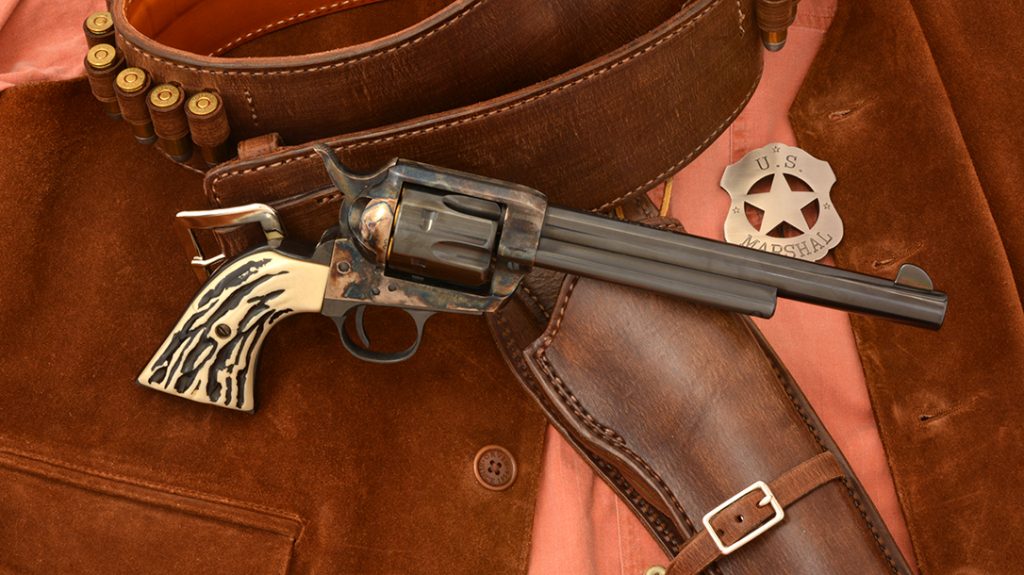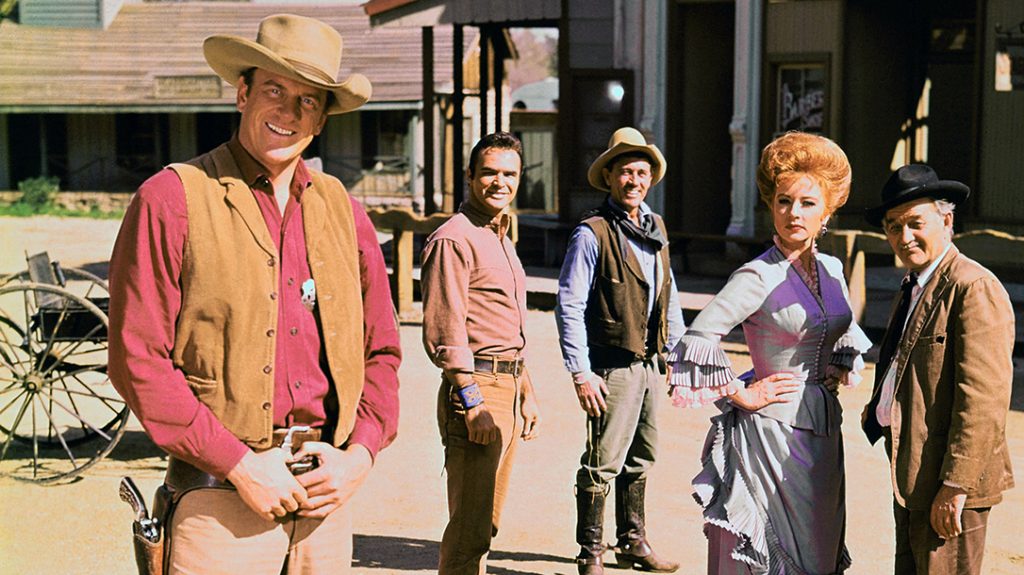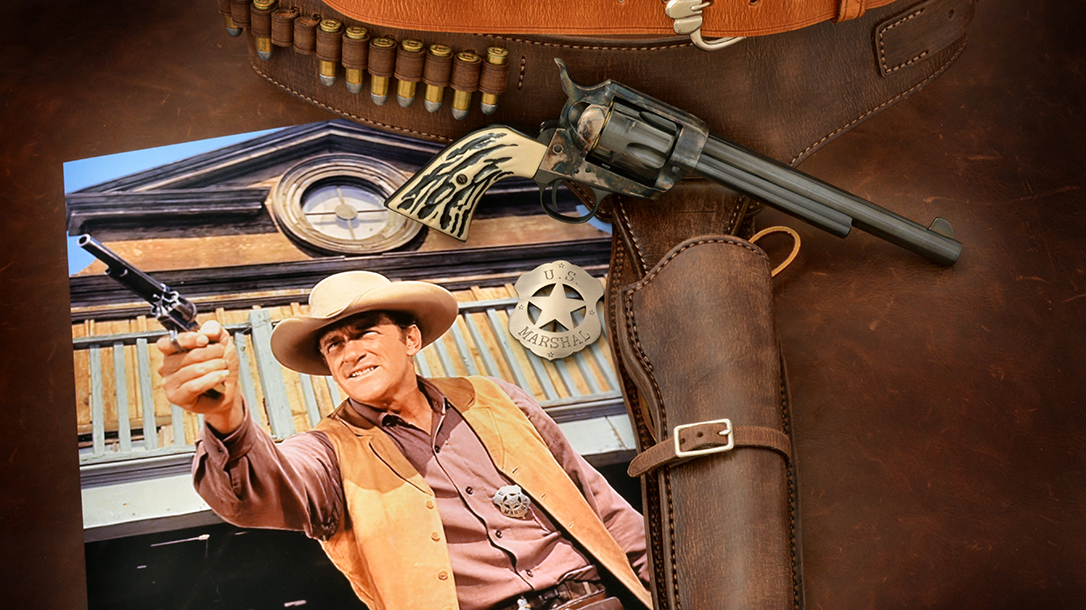Everyone has a “Gunsmoke” story. Almost every major actor today who started out playing small roles on TV from the 1950s to 1970s has one. This includes doctors, lawyers, salespeople, business executives, writers, directors and the guy who owned the old corner grocery store or worked construction in the post-World-War-II housing boom. If you were around in the two decades when “Gunsmoke” was on the air, you had a “Gunsmoke” story. There were a lot of Westerns on TV in those days—some popular, and others fleeting but memorable. But none was as enduring as “Gunsmoke” and its stories of U.S. Marshal Matt Dillon and Dodge City, Kansas.
Celebrating
“Gunsmoke”
The show first aired on Sept. 10, 1955, and the 30-minute, black-and-white series was introduced to TV viewers by John Wayne, a star every moviegoer knew. You have to find the first show of season one to hear that introduction, but it was a good one.
In his opening monologue, Wayne said, “Now, when I first heard about the show ‘Gunsmoke,’ I knew there was only one man to play in it: James Arness. He’s a young fella and may be new to some of you, but I’ve worked with him, and I predict he’ll be a big star.” Indeed, he would be. And, like Wayne, Arness would become a legendary icon in the stories of the American West.
Advertisement — Continue Reading Below
Loading Up
Arness was already an up-and-coming actor who had appeared in some of Wayne’s films. (He was actually under contract to Wayne.) The Duke knew that Arness would be the right fit for the TV series, even though CBS had actually wanted Wayne to play Matt Dillon. Of course, that would never have worked, and Wayne knew it. Even after another actor, Denver Pyle, had been cast to play Matt Dillon, Wayne recommended Arness to CBS. In support of his belief that no one would do a better job, Wayne sold his contract with Arness to the network so he would be free to play Dillon.
Arness tested for the role opposite Amanda Blake as Miss Kitty. The two—who had worked together in motion pictures—were a good match. They possessed all the chemistry their relationship on screen needed to sustain the show through most of the 635 episodes. Blake wasn’t in the final season, but she returned for the first “Gunsmoke” movie in 1987, as would Buck Taylor, who joined the cast in 1967 as Newly O’Brian, Dodge City’s gunsmith and occasional deputy. Taylor remained with the show until it ended in 1975.

Advertisement — Continue Reading Below
Some Backstory
“Gunsmoke” evolved from a 1952 CBS radio show that had its listeners tuning in to hear the authoritative voice of barrel-chested actor William Conrad as Matt Dillon. The imposing stature of James Arness at 6’7” completed the visual image from the very first episode on CBS. But Arness didn’t play the part as it had been envisioned by radio fans, and “Gunsmoke” wasn’t written in the style of other TV Westerns in the 1950s.
These stories had human emotions, friendships, hardships and more gray areas than any previous TV Western. Arness called them “character study shows.” They weren’t the typical white hat/black hat morality plays written for young viewers. This was an adult Western. It broke the mold from the very first episode, with Matt Dillon being gunned down and almost dying. This plot helped establish the show’s supporting cast of Milburn Stone as Doc Adams, Dennis Weaver as Chester Goode, and Amanda Blake as Kitty Russell. All three were film actors. Stone had been a well-established character actor since the late 1930s. The move to a weekly TV show was noteworthy; that was especially for Blake, who kept auditioning for the role until she got it.
Lots of Limpin’
Stone and Weaver were both asked by film director and “Gunsmoke” producer Charles Marquis Warren to join the cast. Warren had worked with both actors in the past, and directed Weaver in the 1955 Civil-War-era drama Seven Angry Men. He said that Weaver, who played the son of abolitionist John Brown (Raymond Massey), was such a fine actor “that I knew he could do anything.” Chester was perhaps one of the show’s strongest and most compelling characters, pretty much invented by Weaver, who had to keep up Chester’s limp for nine years, before he left the series in 1964.
Advertisement — Continue Reading Below
Warren, having set the tone for the TV show, left after the first season. The new showrunner for CBS was Norman Macdonnell, who had been co-creator of the original “Gunsmoke” radio series. He spent the next nine years helming the “Gunsmoke” production and guiding it through its formative years in the 1960s. After 233 half-hour episodes, “Gunsmoke” went to a one-hour format in 1961 during its seventh season. However, the show was still broadcast in black-and-white. The show would not appear in color until 1966, with the start of “Gunsmoke”‘s 12th season.

Dillon & His Sidekicks
Before “Gunsmoke,” Arness had appeared in John Wayne’s Big Jim McLain and Hondo as well as other films. Like his co-stars, Arness found that moving from the big screen to the small screen wasn’t an easy decision. In fact, he almost pulled out at the last minute but was persuaded to give it shot. His first two seasons on the show were hard-fought, until he felt comfortable with the role. But by the third season, Arness had settled in to portraying Matt Dillon, a character he would inhabit for almost 40 years, including the series and five subsequent “Gunsmoke” TV movies from 1987 to 1994. John Wayne had been right—Arness was made for the part.
Advertisement — Continue Reading Below
After Dennis Weaver left “Gunsmoke,” Matt took in a new sidekick. He was the total opposite of Chester Goode: The rough-edged but good-hearted Festus Haggen, played by Ken Curtis. Festus had first been introduced in the 1962 episode “Us Haggens,” which was well received and left the door open for Curtis to step in after Weaver left the show in 1964. Festus was reintroduced in the episode “Prairie Wolfer.”
Wayne Connections
For the next two episodes, both Festus and Chester were in the show, until the April 11, 1964, episode “Bently.” This was Weaver’s last appearance, with Chester determined to prove the innocence of a dying homesteader who had confessed to a murder that Chester was certain he did not commit. At the end, Chester was seen walking down the boardwalk of Front Street toward the railroad depot. He never returned to Dodge City.
Just as Weaver had put the finishing touches on Chester’s character, Ken Curtis crafted the look and personality for Festus. Curtis had actually played a similar role in two episodes of “Have Gun, Will Travel” but refined it for “Gunsmoke.” Once again with Curtis, there was a tie between “Gunsmoke” and John Wayne. Curtis had also come from a film background and had been in a half-dozen movies with Wayne. He was also married to director John Ford’s daughter. He also appeared in “Rio Grande,” “The Searchers,” “The Horse Soldiers,” “The Alamo” and “How the West Was Won,” among other films.
Advertisement — Continue Reading Below
Curtis had also paid his dues playing TV characters on “Have Gun, Will Travel” and in five episodes of “Gunsmoke” before winning the role of Festus. He became a regular on the show for 306 episodes from 1964 to 1975. Western music fans will also recognize Curtis from his singing cowboy days at Columbia Pictures. He was also a member of the Sons of the Pioneers from 1949 to 1951. (The group was featured as the “Regimental Singers” in the film Rio Grande.)
Carving A Path
For the most part, a TV show is considered a success after 100 episodes. Another 100 means a great success. Twenty years is almost unheard of, and “Gunsmoke” was the first show to hit that benchmark. Along the dusty trails from 1955 to 1975, the show was filmed at three different studios. From 1955 to 1960, “Gunsmoke” was shot at the famous Melody Ranch Studio in California’s Santa Clarita Valley.
Filming then continued at the Paramount Studios lot until 1963. After that, the show moved to the massive Stage 3 at CBS Studio Center in the Studio City, Los Angeles. It was through those doors at Melody Ranch, Paramount and CBS that some of the most popular young actors in film and TV history made their first appearances.
Advertisement — Continue Reading Below
Just a rough sampling of actors who played small roles in “Gunsmoke” and later became stars includes Star Trek’s William Shatner, Leonard Nimoy, DeForest Kelley and James Doohan. Screen stars Tom Skerritt, Lee Van Cleef, Slim Pickens, Steve Forrest (as Will Mannon, the most memorable villain in the series), Burt Reynolds (who became a series regular for four years in the 1960s), Dennis Hopper, Harrison Ford, Sam Elliott, Bruce Dern, Charles Bronson, Richard Dreyfuss, Kurt Russell, Morgan Woodward and more than 40 others crossed in and out of “Gunsmoke” over the years, including an actor best known for his character parts in movies and TV shows: Ken Mayer.
On Set With Mayer
Mayer had been a TV star in the 1950s in a series called “Space Patrol”; it was a Flash-Gordon-like space drama for children broadcast on Saturday mornings. But the show began to attract an adult audience during its five-year run. From there, Mayer went on to become one of the busiest character actors in Hollywood. He had one of those familiar faces that kept turning up on TV and in movies for decades.
He was also my neighbor in the 1960s. Ken appeared in 11 episodes of “Gunsmoke” over the years—in 1957, 1958, 1960 and 1965, then early in 1967 and again in December, at which point I was in my first year of college as a photojournalism major.
Advertisement — Continue Reading Below
Rope Fever
When “Gunsmoke” was filming episode 451, “Rope Fever,” which aired on Dec. 4, 1967, Ken hired me to shoot stills of him on the set. That was when I discovered that most of what you saw on the show was actually a massive sound stage at CBS that encompassed much of Dodge City and a lot of the surrounding sets and terrain you saw Matt and Festus covering on horseback. “Gunsmoke” was filmed almost entirely indoors during the 1967 season.
Ken would appear in another five episodes from 1968 to 1973. His characters were either drunks or villains. In “Rope Fever,” he was among the latter, part of a posse led by guest star Ralph Bellamy as Sheriff Bassett, who plans to hang Festus on a trumped-up bank robbery charge. It was on Stage 3 at CBS where I gained my first experience shooting stills on a set. I photographed a sequence of the attempted hanging of Festus, featured here and never published before. But as it turned out, James Arness wasn’t filming on the sound stage that week. I’d have to wait another 42 years to speak with Arness, who graciously wrote the introduction to my 2010 book on John Bianchi. As I said, everyone has a “Gunsmoke” story.
The Accidental Historian
Playwright, actor and author Ben Costello wrote the 577-page book “Gunsmoke: An American Institution in 2005,” to celebrate the show’s 50th anniversary. He grew up watching the show and collecting memorabilia for it. He was at an event, purchasing an entire collection of “Gunsmoke” stills, when one of the sellers said, “You know, the 50th anniversary of ‘Gunsmoke’ is coming up. Why don’t you write a book about it?”
Advertisement — Continue Reading Below
That’s exactly what Costello did. He researched all 635 episodes in his book and explored them with the actors, directors and plots for each. Costello says it took a little more than five-and-a-half years to complete the book. He interviewed former cast members and production workers, including writers like Jim Byrnes, who penned dozens of episodes and the first “Gunsmoke” movie, Return to Dodge. Byrnes ended up writing the foreword to Costello’s book.
What Costello learned from his interviews holds true with the look of the show over the years: “Part of the success of “Gunsmoke” was the character actors in supporting roles. The lead actors always would defer to the character actors, or even each other. Milburn Stone would read a scene and say, ‘You know, I think that would sound better if it came from Festus,’ and this was common among the cast. There were no egos on that set. And when you had a star like James Arness and the supporting cast all working together, it was a perfect combination. CBS had the best people in front of and behind the camera.”
The Later Years
In “Gunsmoke”’s later years, the gunplay was toned down a bit. Even the opening of the show was changed in keeping with the political and social climate of the times. The stories were even more character-driven; it didn’t seem to concern any of the more than 14 million enthusiastic viewers who watched the show every week. There were more shows about women on the frontier. In 1968, Amanda Blake became the first woman inducted into the Hall of Great Western Performers at the National Cowboy & Western Heritage Museum in Oklahoma City.
By the 15th season, the show was still among the top-rated series on TV. There was much more to come in the final five seasons, even as the era of the TV Western was beginning to fade into the past. While locations had occasionally been used for shows throughout the series, the last few seasons had more episodes filmed on location in Arizona and the Southwest, giving viewers solid Western sagas.
While the last episode, “The Sharecroppers,” aired on March 31, 1975, “Gunsmoke” was still far from over. Even with five made-for-TV movies in the 1980s and 1990s marking the official end of “Gunsmoke,” the show has continued in reruns for decades and has entertained three generations with the enduring legacy of Matt Dillon and Dodge City, Kansas. The show’s success is still almost unprecedented. And as much as I hate to end a story about a Western with a Star Trek metaphor, “Gunsmoke” truly went where no TV Western had gone before.
Special thanks to Ben Costello, Doug Abbott, John Bianchi, Alan and Donna Soellner, David R. Greenland and Ronald Jackson.
This article is from the Summer 2020 issue of Guns of the Old West magazine. Grab your copy at OutdoorGroupStore.com.
























